Sedges - Carex
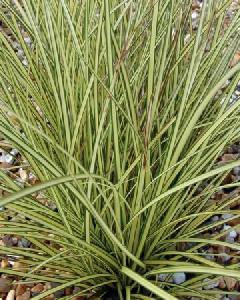 Carex brunnea 'Jenneke' Picture courtesy MalanseunsDescription, History & Interesting Facts:
Carex brunnea 'Jenneke' Picture courtesy MalanseunsDescription, History & Interesting Facts:
Carex are extremely attractive perennial plants which belong to the Sedge family; with over 1000 species and even more cultivars. Most species are evergreen, and can be found growing from the coldest climates and high elevations, to the tropics; so there's one or two suitable for every garden.
All sedges are essentially grass-like in appearance and range in size from extremely small tufts to large clumps. Most garden varieties have striking foliage, a compact mounding habit and cascading leaves.
Foliage can be bronze-brown, dark to light green; or striped with green and cream, ivory or golden-yellow.
In summer the plants produce small brown flower spikes which are attractive but fairly inconspicuous.
(Carex oshimensis 'Variegata')
Variegata has cream and green leaves and the same characteristics and growing requirements as 'Evergold'
 Carex comans 'Bronze' Picture courtesy Malanseuns(Carex oshimensis 'Evergold
Carex comans 'Bronze' Picture courtesy Malanseuns(Carex oshimensis 'Evergold
Evergold is native to the Japanese main island of Honshu and the islands of Shikoku and Kyushu. It is common in dry woods and rocky hillsides at low altitudes, and therefore prefers a slightly drier soil than most sedges. This evergreen has fine foliage which cascades softly to the ground in a fountain-like manner. The striped, creamy-yellow leaves have dark green margins. Its compact growth habit +-15 to 20cm tall and +-20 to 30cm wide, make it an excellent choice for the front of the border. It is fully hardy to frost and thrives in to semi-shade to shade.
(Carex comans Bronze Form) Bronze New Zealand Hair Sedge
This evergreen sedge is native to New Zealand and provides year-round interest with its narrow, weeping leaves which form a dense tussock. The leaves are a warm honey-amber which changes to the shiny copper colour of a new penny in early spring when the new leaves emerge. It will grow in sun or semi-shade to +-30 to 40cm tall and +-50 to 60cm wide. It will adapt to most garden soils and is very hardy to frost, tolerating temperatures down to -5°C; in very cold regions it will go dormant in winter. This sedge does not enjoy excessive wetness in winter.
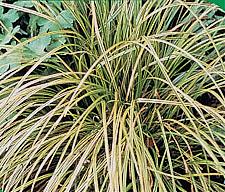 Carex 'Gold Fountain'(Carex comans 'Frosted Curls') New Zealand Hair Sedge
Carex 'Gold Fountain'(Carex comans 'Frosted Curls') New Zealand Hair Sedge
This eye-catching evergreen sedge is native to New Zealand and provides year-round interest with its narrow, pale silvery-green leaves which curl at the tips; shimmering in even the slightest breeze. It forms low matted tufts, which weep as it grows taller. Frosted Curls will grow in sun or semi-shade to +-30cm tall; it can take 4 to 5 years to reach its ultimate height of +-60cm, with a spread of 45cm. Plant it in moist, fertile, well-drained soils, in full sun or semi-shade. This sedge is hardy to frost but in very cold regions it will go dormant in winter.
(Carex brunnea 'Jenneke')
This splendid evergreen sedge makes tufts of slender upright green leaves, which are edged with golden-yellow; when the light catches them, it brilliantly highlights the foliage. Jenneke is hardy to frost and more drought tolerant than most sedges, but responds well to moderate watering in the garden. It can be planted in semi-shade to sun and grows +-40cm tall and 20cm wide; once mature it can exceed these proportions
In the Garden:
Sedges are striking contrast plants for all types of gardens and combine well with other perennials. They are not limited to one garden style and are used in Japanese pebble gardens, tropical and ultra modern designs; cottage and woodland gardens.
They prefer moist soil and thrive near water features and ponds. They also provide an effective groundcover if planted in massed beds; doing well underneath trees. Their compact mounding habit makes them an excellent choice for the front of the border.
Sedges are also great accent plants for mixed container plantings with perennials and annuals.
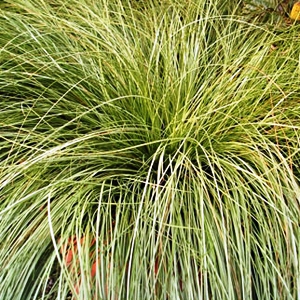 Carex comans 'Frosted Curls' Cultivation/Propagation:
Carex comans 'Frosted Curls' Cultivation/Propagation:
Cultural requirements vary from species to species and most garden varieties available in South Africa remain evergreen and are hardy to frost; in very cold regions they may become dormant in winter.
Some cultivars love semi-shade and will even grow in full shade, while others will adapt to full sun.
Most Sedges love moisture and grow happily in wet, boggy areas, while others are more drought tolerant. Generally they adapt to most fertile well-drained garden soils, from sand to clay loam.
Your local garden centre will stock those varieties most suitable for your region, so check with them first.
Like most perennial grasses sedges will benefit from a tidy up in the spring to remove any dead foliage and to encourage new growth.
Propagation is by seed or by division of the root ball in autumn or spring.
Rock Rose, White Mexican Rose - Echeveria elegans
Agapanthus, Bloulelie - Agapanthus subsp.
Wild Iris, Wilde-Iris, Isiqungasehlati
Chinese Ground Orchid - Bletilla striata
Ice Plant - Delosperma floribunda 'Sequins'
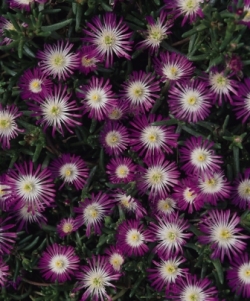 Delosperma 'Sequins' Picture courtey Ball StraathofThe hardy Ice Plants are native to dry areas in South Africa.
Delosperma 'Sequins' Picture courtey Ball StraathofThe hardy Ice Plants are native to dry areas in South Africa.
A striking new introduction in the vygie range is the Delosperma floribunda 'Sequins' selection. The glistening deep purple flowers each have a large white center, and will flower almost the entire summer long; with hundreds of flowers being produced on a single plant. The flowers will attract butterflies and bees to your garden.
This selection forms a low mat of succulent evergreen leaves that spread quickly, making it an excellent groundcover for hot, dry slopes and sandy soils.
For a groundcover, space the plants 45 to 60cm apart. 'Sequins' is lovely if grown in tubs and mixed containers, in the rock garden, or as an edging plant.
This ice plant will grow about 10 to 15cm tall and can spread 45 to 60cm. It is a low maintenance plant that is extremely hardy to heat, cold and frost; and is very drought tolerant. Plant it in full sun and well-drained soil. It should not be over watered and only needs fertilising once a month. In regions with wet soils in winter this will likely perform as an annual.
Dichondra 'Silver Falls' - Dichondra argentea
Hottentots Fig, Kaapsevy - Carpobrotus edulis
 Carpobrotus deliciosus Description:
Carpobrotus deliciosus Description:
This vigorous, flat-growing, succulent groundcover grows on coastal and inland slopes from Namaqualand in the Northern Cape, through the Western Cape to the Eastern Cape. The huge bright yellow flowers appear mainly from late winter to spring and fade to pink. They open in bright sunlight, and close at night. This species is easily distinguished from the others as it is the only one with yellow flowers.
(Carpobrotus deliciosus) Goena can be found growing from Riversdal to the Eastern Cape. It has attractive purple, pink or white flowers and its growth habit and uses are the same as for C. edulis.
In the Garden:
Because it is drought resistant, low maintenance and fast growing, it is often seen as a pioneer plant on disturbed sites and in large areas it is essential for the fast stabilization of sandy slopes. In areas prone to wild fires, it makes a good fire-resistant barrier.
Uses:
Medicinally it is used for skin ailments and to treat stings, especially bluebottle stings.
The fruits are used to make jams and condiments.
 Carpobrotus edulis
Carpobrotus edulis
In the Garden:
It will grow in full sun or in the dry shade under trees. Plant it as a groundcover for large areas, on embankments, or allow it to cascade over terrace walls. It is relatively shallow-rooting and is also a good choice for a roof garden.
Cultivation/Propagation:
The Hottentots fig is one of those plants that thrive on neglect and can be killed with kindness.
It is an excellent evergreen that is both drought and wind-resistant and will grow in lime-rich and brackish soils.
It is tender to frost, and high humidity will cause bacterial rot of the leaves.
Do not fertilise, and plant it in well-drained soil, in a sunny position where it has room to spread.
This drought tolerant plant should not need additional irrigation once established.
(Carpobrotus edulis) roots easily from cuttings without the need for hormone powder. Cuttings can rot easily, so root them in sand.
Rose-scented Pelargonium, Kusmalva - Pelargonium capitatum
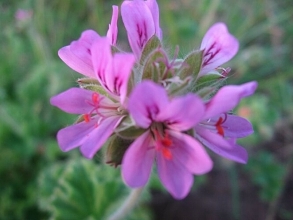 Pelargonium capitatum Description, History & Interesting Facts:
Pelargonium capitatum Description, History & Interesting Facts:
The rose-scented pelargonium occurs all along the coastline, from Lamberts Bay on the Namaqualand Wild Flower Route, to the Peninsula and through to Port Elizabeth and the Eastern Cape and into KwaZulu-Natal. It can be found growing on sand and limestone near the coast, on disturbed areas, low hillsides and coastal sand dunes.
It is a bushy, widely spreading, low-growing plant that produces pretty pink flowers in spring and summer, and has sweetly scented hairy leaves that smell of roses when crushed. It will grow quickly to about 30cm tall and 1.5m wide.
Uses:
This pelargonium is cultivated for its rose scented oil that is extracted from the leaves. The leaves are used in pot-pourri, and make a pleasant herbal tea to treat coughs and fever, colic, flatulence, vomiting, diarrhoea, nausea, stomach cramps, kidney and bladder ailments.
It also has relaxing and astringent properties. The leaves can be rubbed into the skin to soften and soothe cracks, calluses and scratches. They can also be made into a poultice for bruises, stings and abscesses; and are added to bath water to sooth rashes. Always seek advice from a professional before using a plant medicinally.
In the Garden:
The rose-scented pelargonium is used to stabilise dunes in re-vegetation projects and, because it spreads widely; it makes an excellent groundcover for coastal gardens.
Cultivation/Propagation:
This versatile perennial plant will grow happily, with minimum care, in sun or semi-shade.
It is semi-hardy to frost if it is planted in a warm, protected position in the garden and is kept on the dry side in winter.
Although this plant is water-wise; for good results in the garden, plant it into composted soil, water it moderately during dry spells and feed it with 3:1:5 during the flowering season.
Prune it fairly hard after it has flowered, to keep it in shape.
Pelargonium capitatum can easily be grown from seeds and softwood cuttings.
